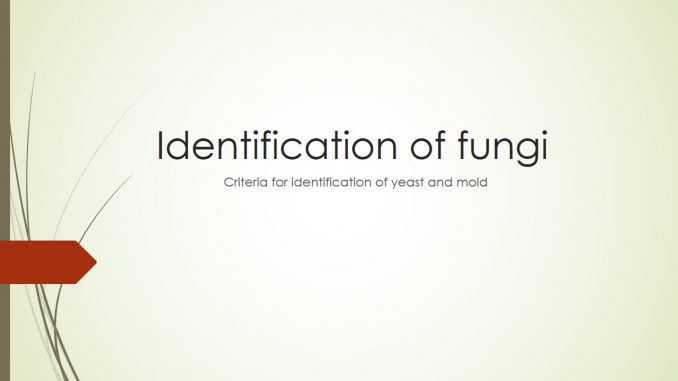
Identification of fungi: criteria for identification of yeast and mold
- The identification of fungi is made using combination of
- Growth rate
- Colonial morphological feature
- Microscopic observation
1. Growth rate
- Growth rate is one of the helpful observation made when examining fungi. However this information may be of limited value since the growth rate of certain fungi is variable depending upon the inoculum.
- In general growth rate of dimorphic fungi such as Blastomyces dermatitidis, Histoplasma capsulatum is 1-4 weeks.
- Colonies of Zygomycetes appears within 24 hours
- Similarly, Saccharomyces give visible colonies in 3-5 days
2. Colonial morphological feature:
- Colony morphology is one of the important feature of fungi but still it has limited value in identification of mold because of natural variation among isolates and variation of colonies on different culture media.
- When examining the colonial morphological feature of fungi, types of culture media used and incubation condition should be considered. For example Histoplasma capsulatum appears as a white mold on BHI agar and appears as yeast when grown on same media containing blood enrichment.
- Colonial morphology can be used to supplement the information obtained from microscopic examination.
3. Microscopic observation:
- In general, microscopic morphological feature of fungi are stable and exhibit minimal variation.
- The definite identification is based on characteristics, shape, methods of production and arrangement of spores. However, the size of hyphae also provides helpful information identification of fungi.
- For microscopic examination, stained preparation is performed.
Common used staining reagent in microscopic observation are;
- Lactophenol cotton blue: stains cytoplasm
- Cresyl blue stain: stains spore wall of basidiomycetes
- Periodic acid Schiff (PAS) stain: distinguish hyphae from other fungal elements
- Hematoxylin stain: stains nucleus in filamentous fungi
- Giemsa stain: stains nucleus in filamentous fungi
- Calcofluor white stain
- India ink
- Wright stain
Criteria used in identification and differentiation of yeast and mold
Criteria for Identification of yeast:
- Whether ascospore are formed or not
- If they form ascospore; appearance and number of ascospore
- Appearance of vegetative cell;
- Shape
- Size
- Methods of asexual reproduction
- Production of mycelium, pseudomycellium or no mycelium production
- Color of macroscopic growth
- Oxidative or fermentative
Criteria for identification of mold:
- Types of hyphae; septate or non-septate
- Mycelium; clear or dark
- Color of mycelium; colored or colorless
- Types of sexual spores
- Types of asexual spores
- Characteristics of aerial hyphae or spore;
- Sporangia; size, color, shape and location
- Conidia; arrangement of conidia ( chain, budding, single or masses), shape, and arrangement of sterigmata or phiallides
- Arrangement of soprangiophore or conidiophore; simple or branched (type of branching), size, shape of collumela at tip of sporangiophore
- Single conidiophore or bundle of conidiophore
- Presence of special structure; stolen, rhizoids, apophysis etc
